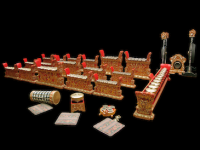Videos
Description
In English
Gong kebyar is a Balinese gamelan bar with a five-tone pelog that creates a musical expression with a nuance of kebyar. Gong kebyar presents “tabuh-tabuh kekebyaran” in the form of a composition that plays all the gamelan instruments simultaneously in polythmic, dynamic and harmonious accents. Musically, the Gamelan Gong Kebyar according to Sugiartha (2008: 51), is a traditional Balinese orchestra that has a strong temperament (coarse sounding ensamble). The harmonious construction that creates the unity of the Gong Kebyar gamelan is dominated by percussion instruments, plus several wind and string instruments. As a gamelan that serves to present pategak (instrumental) repertoire, accompany various types of dances and is used as a learning medium, Gong Kebyar has been known and became popular so quickly and is able to inspire the enthusiasm of Balinese gamelan lovers who have spread to almost various parts of the world.
Gong Kebyar which was predicted emerging in 1915 has been known by Bali people, even now every banjar and village in Bali has Gong Kebyar that functions as various need such as performing art for both entertainment and ritual presentation. I Wayan Rai (2008: 7-8) mentions that in Bali there have been recorded no less than 1,600 barung gamelan Gong Kebyar, of course this number is increasing over time. Some of these gamelan belong to the banjar, village, formal institutions, and individuals. This number is added to the large number of Gamelan Gong Kebyar groups scattered in various cities in Indonesia and abroad.
Abroad, Gong Kebyar was initially known via literature and records. One of the records was produced by Odeon and Beka who has recorded the gending-gending (the songs) Gong Kebyar, such as Kebyar Ding Sempati in Belaluan (Badung). In 1931 Sekaa Gong Kebyar Peliatan was performing in the contect of Colonial Exposition in Paris. The visit was continued in 1952 – 1953 to USA. These two tours were strengthening the existence of gamelan Gong Kebyar in the world.
Until nowadays, Gong Kebyar always becomes a medium of diplomacy of Indonesian culture. Arts group and gamelan Gong Kebyar are sent and employed in the embassy of other nation, that strengthen the bilateral relation between Indonesia and other countries around the world.
Gamelan Gong Kebyar has been developing so rapidly and having appreciation until nowadays, because Gong Kebyar is a simple ensemble and has high flexibility. The presentation of Gong Kebyar gives an unlimited space for the players (such as sekaa gong : kids, women, adolescence, mixed adolescence, adult including werdha/old men) to have creativeness, and can give an attractive touch with more alive and dynamic performance.
The quantity of the instruments in one barungan for the gamelan Gong Kebyar is not all the same. Gong Kebyar with the most complete instrument is called the Gong Kebyar Barungan Jangkep (Barungan Ageng) which consists of 21 types of tools, each of which has its own name and specific function for its barungan, namely:
1. One tungguh trompong, with 10 pencon
2. One tungguh reyong,with 12 pencon
3. A pair of giying, with 10 keys
4. Two pairs of pemade, with 10 keys
5. Two pairs of kantilan, with10 keys
6. A pair of kenyur, with 7 keys
7. A pair of calung, with 5 keys
8. A pair of jegogan, with 5 keys
9. A pair of kendang cedugan
10. A pair of kendang gupekan
11. A pair of kendang krumpungan
12. One kajar
13. One kempur
14. One bende
15. One kemong
16. One kempli
17. A pair of gong lanang-wadon
18. One pangkon cengceng gecek
19. Eight cakep (pairs) cengceng kopyak
20. Two small suling and eight big suling
21. One rebab
Musically gamelan Gong Kebyar uses pelog lima nada /pelog with five tones, the same as the pelog system with five tones in other types of gamelan , such as gamelan Gong Gede, Gong Kebyar and Palegongan, with the sequence of tones as follows : nding, ndong, ndeng, ndung, and ndang. In addition, in the Balinese gamelan tuning system there is the term ngumbang-ngisep. Ngumbang-ngisep are two equal tones, intentionally made into a slight different frequency. If these two tones pangumbang and pangisep played together at the same time, they will produce sound wave which is asthetically one of the form of beauty in karawitan Bali.
In Gong Kebyar, there is also a concept of balance which is oriented towards "dualism" of good and bad or which includes similarities and differences. This concept can be seen in the themes of Balinese art, which mostly depart from this dualism, so that strong norms and ethics emerge and become part of art performances. The concept of a two-dimensional balance can produce symmetrical shapes that are at the same time asymmetrical or a harmonious and disharmonic braid which is commonly known as Rwa Bhineda. In the concept of rwa bhineda, there is also a spirit of togetherness, the existence of interrelation and competition to create interaction and competition. Balance in the second dimension is one of the basic concepts in Balinese music, including the gamelan Gong Kebyar.
This is reflected in the traditional Gong Kebyar instruments made in pairs; lanang - wadon or male female, this term is used in the naming of the drums and gongs.The tuning system ngumbang – ngisep ; the same tones with different frequency, the lower tone is called ngumbang and a slight higher tone is called ngisep. The elements of tones or sounds combination have been identical in Balinese traditional music, almost all types of Balinese gamelan have playing basics varied terms, such as : kotekan, cecandetan, tetorekan and ubit-ubitan. The playing technique kotekan ; uses sangsih (off-beat), polos (on-beat). These are the symbol of balance elements which are not always parallel, but in a competitive interaction.
In general, it can be observed that the structure the Gong Kebyar repertoire consists of three main parts , namely: kawitan, pangawak and pangecet. Kawitan is supposed to be the head, pangawak is body, and pangecet is the legs. These parts are portioned out equally, in which the rwa bhineda system is always in it in order to produce harmony in each part or harmony among parts. Conceptually, these two elements become dualism that is always reflected in artistic activities in Bali.
In Balinese
GongEnglishgamelan instrumentIndonesiangong
EnglishborrowIndonesianpinjam
EnglishbaliIndonesianbali
EnglishuseIndonesianmenggunakan, memakai
EnglishhandIndonesiantangan
EnglishsoundIndonesiansuara
EnglishsongIndonesianlagu
EnglishwithIndonesianoleh
EnglishallIndonesiansemua
Englishtool, kind ofIndonesianalat
Englishaccording toIndonesiansesuai
EnglishtalkIndonesianmembicarakan
Englishgamelan instrumentIndonesiangong
EnglishbaliIndonesianbali
EnglishhaveIndonesianmemiliki
EnglishcoarseIndonesiankeras
EnglishasIndonesiansebagai
Englishto put onIndonesianpakai
EnglishalsoIndonesianjuga
EnglishmaterialIndonesiansarana
Englishto learnIndonesianbelajar
EnglishfastIndonesiancepat
EnglishinfluenceIndonesianmenarik
EnglishmindIndonesiankeinginan
EnglishhumanIndonesianmanusia
Englishwhole areaIndonesianseluruh wilayah
Englishthe environtmentIndonesianlingkungan
Englishto desireIndonesianberkeinginan
Englishlike thisIndonesianbegini
GongEnglishgamelan instrumentIndonesiangong
Englishto cause to come outIndonesianke luar
EnglishaboutIndonesiankira-kira
Englishfiber, kind of aIndonesianketika
EnglishyearIndonesiantahun
EnglishalreadyIndonesiansudah
EnglishwidelyIndonesianumum
Englishcustomary lawIndonesianadat istiadat
EnglishknowIndonesiantahu
EnglishaboutIndonesianperihal
Englishlike thisIndonesianbegini
EnglishmanyIndonesianbanyak
EnglishcommunityIndonesiankomunitas
EnglishvillageIndonesiandesa
EnglishcommunityIndonesiankomunitas
EnglishhaveIndonesianmemiliki
Englishgamelan instrumentIndonesiangong
EnglishalsoIndonesianjuga
Englishthe personIndonesianorang itu
EnglishuseIndonesianmenggunakan, memakai
EnglishsomeIndonesianbeberapa
EnglishcostumaryIndonesiansegala tata cara adat
EnglishceremonyIndonesian-
EnglishceremonyIndonesianpersembahan
Englishthe name for the first childIndonesiansebutan untuk anak pertama
EnglishauspiciousIndonesianadik
EnglishtalkIndonesianmembicarakan
EnglishbaliIndonesianbali
Englishthere isIndonesianada
Englishone thousandIndonesianseribu
EnglishcounterIndonesiantanding
EnglishonlyIndonesiansaja
EnglishnowIndonesiansekarang
EnglishwaitIndonesianmenunggu
Englishbelongs toIndonesianmilik
EnglishholdIndonesiankeberadaan
EnglishstillIndonesianmasih
EnglishtownIndonesiankota
EnglishcountryIndonesiannegara
Ring dura NegaraEnglishcountryIndonesiannegara
Englishgamelan instrumentIndonesiangong
EnglishknownIndonesiandiketahui
EnglishborrowIndonesianpinjam
Englishby means ofIndonesianoleh
Englishlet'sIndonesianayo
EnglishalreadyIndonesiansudah
EnglishsongIndonesianlagu
Englishaccording toIndonesiansebagaimana
Englishone of the tones of the five tones in balinese gamelan (music)Indonesiansalah satu nada dari panca nada dalam gamelan bali
Englisha tree whose fruit is round as big as a tomato, yellow, and has a sour tasteIndonesianpohon yang buahnya berbentuk bulat sebesar tomat, berwarna kuning,dan rasanya masam
Englishfiber, kind of aIndonesianketika
EnglishyearIndonesiantahun
Englishone thousandIndonesianseribu
EnglishtenIndonesiansepuluh
EnglishassociationIndonesianperkumpulan
EnglishperformanceIndonesiantontonan
EnglishplanIndonesianacara
Englishplease go aheadIndonesiansilakan
EnglishfiftyIndonesianlima puluh
Englishlike thisIndonesianbegini
EnglishsuccessfullyIndonesianselesai dengan baik
EnglishupgradeIndonesianmeningkatkan
EnglishholdIndonesiankeberadaan
Ngantos mangkinEnglishnowIndonesiansekarang
Englishgamelan instrumentIndonesiangong
EnglishalwaysIndonesianselalu
EnglishmayIndonesianboleh
EnglishcountryIndonesiannegara
EnglishassociationIndonesianperkumpulan
EnglishinviteIndonesiandisuruh
EnglishofficeIndonesiankantor
EnglishupgradeIndonesianmeningkatkan
EnglishjoinIndonesianikut
Englishanything elseIndonesianyang lain
Sane mangkinGamelan GongEnglishgamelan instrumentIndonesiangong
EnglishsuccessfullyIndonesianselesai dengan baik
EnglishfastIndonesiancepat
EnglishgetIndonesianberhasil
EnglishbecauseIndonesianoleh karena
Englishlike thisIndonesianbegini
Englishgamelan instrumentIndonesiangong
EnglishgiveIndonesianmemberi
EnglishplaceIndonesiantempat
EnglishfirstIndonesianpaling
EnglishbroadIndonesianlebar
English-Indonesianterutama
EnglishassociationIndonesianperkumpulan
EnglishalsoIndonesianjuga
EnglishshowIndonesianmelahirkan
Piranti-piranti gamelan gongEnglishgamelan instrumentIndonesiangong
Englishlike thisIndonesianbegini
EnglishfirstIndonesianpaling
EnglishcompleteIndonesianlengkap
Englishto be calledIndonesiandinamakan
EnglishbigIndonesianbesar
EnglishwithIndonesianoleh
EnglishgroupIndonesianjenis
EnglisheachIndonesianmasing-masing
EnglishhaveIndonesianmemiliki
EnglishsqueezeIndonesiannama
EnglishbenefitsIndonesianmanfaat
EnglishdifferentIndonesianberbeda
English-Indonesianterutama
1. Atungguh trompongEnglishdance, kind of aIndonesiansalah satu bagian dari instrumen gamelan
Englishan instrument used in balinese gamelan musicIndonesiansebuah instrumen gamelan di bali
Englishgamelan instrumentIndonesian-
EnglisheachIndonesianmasing-masing
EnglishuseIndonesianmenggunakan, memakai
EnglishcompleteIndonesianlengkap
Englishgamelan instrumentIndonesian-
English-Indonesiantempat garam terbuat dari tempurung kelapa.
Englishgamelan instrumentIndonesiangamelan
Englishdrum, kind of aIndonesian-
Englishone of the balinese gamelan instruments that acts as a mat holder (rhythm)Indonesiansalah satu alat gamelan bali yg berperan sebagai pemegang mat (irama)
Englishgamelan instrumentIndonesiangamelan
Englishgamelan instrumentIndonesian-
EnglishmusicIndonesiansalah satu alat gamelan bali (spt canang)
English-Indonesiangamelan
Englishgamelan instrumentIndonesiangong
Englishbalinese traditiona instrumentIndonesiangamelan
Englishpress with nailsIndonesiantekan dengan kuku
EnglisheightIndonesiandelapan
EnglishencloseIndonesianlontar
EnglishsmallIndonesiankecil
EnglishbigIndonesianbesar
EnglishmusicalIndonesianrebab
Gamelan gongEnglishgamelan instrumentIndonesiangong
EnglishuseIndonesianmenggunakan, memakai
EnglishresembleIndonesianmirip
EnglishsoundIndonesiansuara
EnglishsimilarIndonesiansama
EnglishbaliIndonesianbali
Englishanything elseIndonesianyang lain
Englishgamelan instrumentIndonesiangong
EnglishbigIndonesianbesar
EnglishwithIndonesianoleh
English-Indonesianterutama
Englishone of the tones of the five tones in balinese gamelan (music)Indonesiansalah satu nada dari panca nada dalam gamelan bali
EnglishmusicIndonesiansalah satu dr panca nada dl gamelan bali
Englishanything elseIndonesianyang lain
Englishthere isIndonesianada
Englishto be calledIndonesiandinamakan
EnglishsimilarIndonesiansama
EnglishhaveIndonesianmemiliki
Englishwooden or bamboo blades mounted on rafters where tiles are installedIndonesianbilah-bilah kayu atau bambu yang dipasang pada kasau tempat memasang genting
EnglishsmallIndonesiansedikit
EnglishbothIndonesiankeduanya
EnglishdefiniteIndonesianpasti
EnglishalreadyIndonesiansudah
EnglishdifferentIndonesianberbeda
EnglishbutIndonesiantetapi
Englishto cause to come outIndonesianke luar
EnglishgoodIndonesianbaik
Ring gongEnglishgamelan instrumentIndonesiangong
EnglishalsoIndonesianjuga
EnglishknownIndonesiandiketahui
Englishto be calledIndonesiandinamakan
EnglishliveIndonesianhidup
EnglishwithIndonesianoleh
Englishlike thisIndonesianbegini
EnglishoftenIndonesiankikir
Englishseen byIndonesiandilihat (oleh)
EnglishstickIndonesiansepotong batang kayu
EnglishbaliIndonesianbali
Englishpriority, prominent, specialIndonesianmengutamakan
EnglishfenceIndonesianperaturan
EnglishorderIndonesianaturan
EnglishbridgeIndonesiantitian
EnglishmayIndonesianboleh
EnglishperformanceIndonesiantontonan
EnglishintersectionIndonesianperempatan
EnglishalreadyIndonesiansudah
Englishthere isIndonesianada
Englishgamelan instrumentIndonesiangong
EnglishwhatIndonesianbagaimana
EnglishdifferentIndonesianberbeda
EnglishbutIndonesiantetapi
EnglishsuccessfullyIndonesianselesai dengan baik
Englishto cause to come outIndonesianke luar
EnglishgoodIndonesianbaik
Indike punikiEnglishlike thisIndonesianbegini
EnglishsuccessfullyIndonesianselesai dengan baik
Englishtool, kind ofIndonesianalat
Englishgamelan instrumentIndonesiangong
Englishdrum, kind of aIndonesian-
EnglishsimilarIndonesiansama
EnglishbutIndonesiantetapi
EnglishdifferentIndonesianberbeda
EnglishareaIndonesianwilayah
Englishto cause to come outIndonesianke luar
Englishplease go aheadIndonesiansilakan
EnglishoftenIndonesiankikir
Englishused asIndonesiandipakai (oleh)
Englishto moveIndonesianmengolahnya
EnglishprodIndonesianmenjolok
Englishto hit in turnIndonesianmemukul lesung beramai-ramai dengan irama bersahut-sahutan
EnglishuseIndonesianmenggunakan, memakai
EnglishfenceIndonesianperaturan
EnglishhonestIndonesiansangat sederhana
EnglishrelevantIndonesian-
Englishone of the balinese gamelan instruments that acts as a mat holder (rhythm)Indonesiansalah satu alat gamelan bali yg berperan sebagai pemegang mat (irama)
EnglishdifferentIndonesianberbeda
Englishdoesn'tIndonesiantidak
EnglishallIndonesiansemua
EnglishgoodIndonesianbaik
Ketahnyane prasidaEnglishsuccessfullyIndonesianselesai dengan baik
EnglishsongIndonesianlagu
Englishgamelan instrumentIndonesiangong
EnglishhaveIndonesianmemiliki
English-Indonesianterutama
Englishaccording toIndonesiansebagaimana
EnglishheadIndonesiankepala
EnglishbodyIndonesianbadan
EnglishfootIndonesiankaki
EnglishallIndonesiansemua
Englishto come fromIndonesianasal
Englishdoesn'tIndonesiantidak
English-Indonesiandipisahkan
Englishso thatIndonesianagar
EnglishshowIndonesianmelahirkan
Gong kebyar inggih punika silih sinunggil gamelan Bali sane nganggen laras pelog lima nada sane ngametuang gending tetabuhan kekebyaran. Gong kebyar maktayang tetabuhan kekebyaran antuk wangun komposisi sane nabuhang makasami piranti gamelane risajeroning aksentuasi sane poliritmik, dinamis miwah harmonis. Manut Sugiartha (2008: 51) maosang, gong kebyar inggih punika orkestra tradisional bali sane madue ceciren keras. Konstruksi harmonis ngametuang paiketan gamelan kebyar sane akehang medaging piranti perkusi, piranti sane kaupin, miwah piranti sane mekaradan. Pinaka gamelan sane kawigunannyane anggen tabuh pategak (instrumental), nabuhang tari-tarian taler anggen sarana melajah, gamelan gong kebyar gelis ngelimbak tur nudut kayun para yowanane miwah para jana ring sajebag jagate meled mlajahin gamelan gong kebyar puniki.
Gong kebyar kakantenan metu sawatara duk warsa 1915, sampun ketah krama baline uning indik gamelan puniki, tur sampun akeh banjar, utawi desa miwah sanggar sane madue gamelan gong kebyar puniki, punika taler makueh anake nganggen gamelan gong kebyar ring makudang-kudang parikrama sakeng presentasi estetik murni ngantos kaanggen ritatkala ngiringan upacara Yadnya. I Wayan Rai (2008: 7-8) maosang ring Bali sawatara wenten 1600 (siu telung atak) barung gong kebyar. Wantah mangkin jumlahnyane nyantos bertambah. Gamelan puniki wenten sane druen banjar, desa, lembaga formal, miwah druen krama niri-niri. Kawentenan punika kantun kawewehin malih sakeng makuehne barungan gamelan gong kebyar ring makudang-kudang kota ring Indonesia taler nyantos ring dura negara.
Ring dura Negara, gong kebyar kapertama kauningin sakeng literatur miwah rekaman. Silih sinunggil rekaman punika kaasilang olih Odeon lan Beka sane sampun ngerekam gending gong kebyar sekadi Kebyar Ding sempati ring Belaluan Badung, duk warsa 1931 (siu sangangatus telung dasa siki) sekaa gong kebyar Peliatan ngawentenang balih-balihan ring acara Colonial Exposition ring Paris. Raris kelanturang malih ring warsa 1952 (siu sangangatus seket kalih)-1953(siu sangangatus seket tiga) ring Amerika Serikat. Makalih tour kesenian puniki prasida nincapang malih kawentenan gong kebyar druene.
Ngantos mangkin gamelan gong kebyar setata dados media diplomasi kebudayaan sakeng Negara Indonesia. Wentenne sekaa gong kebyar sane kautus miwah kagenahang ring kantor kedutaan Negara kaanggen nincapang miwah pasawitran ring paiketan sakeng Indonesia sareng panegara tiosan.
Sane mangkinGamelan Gong Kebyar prasida gelis ngalimbak miwah polih apresiasi positif, santukan gamelan puniki praktis tur fleksibel. Gamelan gong kebyar ngicenin genah kreatifitas sane pinih jimbar majeng ring pengrawtine. Minakadi sekaa gong alit-alit, bajang-bajang, truna-truna, truna-truni, taler werdha prasida ngamijilang kreasine tur prasida matetabuhan sane atraktif tur metaksu.
Piranti-piranti gamelan gong kebyar puniki jangkepne makueh metiosan. Yening gong kebyar sane pinih jangkep kawastanin gamelan gong kebyar barungan jangkep utawi barungan ageng sane kawangun antuk 21 (selikur) soroh pirantine. Soang-soang pirantine punika madue pesengan tur kawigunan sane matiosan, minakadi :
1. Atungguh trompong, medaging 10 pencon
2. Atungguh reong, medaging 12 pencon
3. Ajangkepan Giying soang-soang nganggen 10bilah
4. Kalih jangkep Pemade, soang-soang nganggen 10 bilah
5. Kalih jangkep Kantioan, soang-soang nganggen 10 bilah
6. Ajangkepan Kenyur soang-soang nganggen 7 bilah
7. Ajangkepan Calung, soang-soang nganggen 5 bilah
8. Ajangkepan Jegog, soang-soang nganggen 5 bilah
9. Ajangkepan kendang cedugan
10. Ajangkepan kendang gupekan
11. Ajangkepan kendang krumpungan
12. Kajar asiki
13. Kempli asiki
14. Kempur asiki
15. Bende asiki
16. Kemong asikih
17. Gong lanang-wadon
18. Apangkon cengceng gecek
19. Kutus cakep cengceng kopyak
20. Kalih suling alit, tur akutus suling ageng.
21. Rebab asiki.
Gamelan gong kebyar nganggen saih pelog 5 nada wastanne. Pateh sakadi saih pelog 5 nada gamelan bali sane tiosan, sakadi gamelan Gong Gede, miwah Gong Palegongan antuk jajaran suarane minakadi : Ding, Dong, Deng, Dung, Dang. Tiosan punika ring gamelan bali wenten sane kawastanin Ngumbang-ngisep. Ngumbang-Ngisep inggih punika kakalih suara sane pateh, sakemaon madue frekuensi utawi reng sane metiosan malih akidik. Yening makakalih suara ngumbang-ngisep nika tabuhang janten sampun ngawetuang reng suara sane mabinayan sakewanten kakantenan metu suara sane becik tur lengud kapirengan.
Ring gong kebyar taler kauningin sane kawastanin “keseimbangan” inggih punika tatacara idup sane madasar antuk Rwa Bhineda, jele-melah, becik-kaon, pateh-matiosan. Indike puniki sering kacingak ring bantang Kesenian Bali sane ngutamayang rwa bhineda puniki ngantos mijil uger-uger miwah tata titi sane dados papalihan ring balih-balihan keseniane punika. Parindikan keseimbangan utawi papadan puniki ngametuang wangun-wangun sane simetris miwah asimetris, ngametuang suara sane harmonis utawi disharmonis, niki sampun sane kawastanin Rwa Bhineda. Rwa Bhineda puniki sane wenten ring gamelan Gong kebyar, sapunapi suara-suara sane mabinayan kawigunanyane, mabinayan suarane, sakewanten rikalaning nabuhang gamelane punika prasida metu tetabuhan sane becik, lengud, tur ngelangenin.
Indike puniki prasida kapanggihin ring piranti gong kebyar sane wangunnyane mapasang-pasangan utawi mejangkepan. Lanang-wadon sane kaanggen ring ajangkepan kendang miwah gong. Ngumbang-ngisep, suarane pateh sakewanten frekuensine mabinayan, kaanggen ring suara2 sane mabilah tur mapencon. Ring wewidangan tatacara nabuhin gamelane punika metu raris istilah-istilah sane sering kangge ritatkala ngolah suarane minakadin ngotek, norot, cecandetan, ngoncang, ubit-ubitan. Tatacara ngotek utawi kotekan inggih punika nganggen uger-uger polos sane suarane nganutin kajar, sangsih suarane nenten nganutin kajar. Makasami ngawentenan ceciren-ceciren Rwa Bhinedane sakewantenan metu sane becik.
Ketahnyane prasida kapanggihin wangun-wangun gending gong kebyar madue pah-pahan wangun minakadi, kawitan, pengawak, miwah pengecet. Kawitan nirgamayang sekadi sirah imanusane, pengawak nirgamayang sekadi awak i manusane, pengecet nirgamayang sekadi batis i manusane. Makasami pah-pahane punika mawit sakeng rwa bhineda sane nenten prasida kapasahang mangda prasida ngamijilang tetabuhan sane prasida ngelangonin.
In Indonesian
Gong kebyar adalah salah satu barungan gamelan Bali berlaras pelog lima nada yang melahirkan ungkapan musikal benuansa kebyar. Gong kebyar menyajikan “tabuh-tabuh kekebyaran” dengan bentuk komposisi yang memainkan seluruh alat gamelan secara serentak dalam aksentuasi yang poliritmik, dinamis dan harmonis. Secara musikal gamelan Gong Kebyar menurut Sugiartha (2008 : 51), adalah sebuah orkestra tradisional Bali yang memiliki perangai keras (coarse sounding ensamble). Konstruksi harmonis yang melahirkan kesatuan perangkat gamelan Gong Kebyar didominasi oleh alat-alat perkusi, ditambah dengan beberapa alat tiup dan gesek. Sebagai gamelan yang berfungsi menyajikan gending-gending pategak (instrumental), mengiringi berbagai jenis tarian maupun dimanfaatkan sebagai media pembelajaran, Gong Kebyar telah dikenal dan menjadi populer dengan begitu cepat dan mampu menggugah semangat para pencinta gamelan Bali yang menyebar hampir di berbagai belahan dunia.
Gong Kebyar yang diduga muncul pada tahun 1915, memang sudah umum dikenal oleh masyarakat Bali bahkan kini telah dimiliki hampir oleh setiap banjar dan desa di Bali, yang memfungsikan barungan gamelan ini untuk berbagai kepentingan, dari pentas seni yang bersifat presentasi estetik murni, hingga untuk mengiringi upacara ritual keagamaan. I Wayan Rai (2008:7-8) menyebutkan di Bali telah tercatat tidak kurang dari 1.600 barung gamelan Gong Kebyar tentu jumlah ini kian bertambah. Gamelan ini ada yang milik banjar, desa, lembaga formal, maupun perseorangan. Jumlah tersebut masih ditambah lagi dengan banyaknya barungan gamelan Gong Kebyar yang tersebar diberbagai kota di Indonesia dan manca negara.
Di luar negeri, Gong Kebyar mula-mula dikenal lewat literatur dan rekaman. Salah satu rekaman itu adalah yang dihasilkan oleh Odeon dan Beka yang telah merekam gending-gending Gong Kebyar, seperti Kebyar Ding Sempati di Belaluan (Badung). Pada tahun 1931 Sekaa Gong Kebyar Peliatan mengadakan pertunjukan dalam rangkan Colonial Exposition di Paris. Lawatan sekaa ini dilanjutkan lagi tahun 1952 – 1953 ke Amerika Serikat. Kedua tour ini sudah tentu semakin menguatkan eksistensi gamelan Gong Kebyar di mata dunia.
Sampai dewasa ini Gong Kebyar selalu menjadi salah satu media dari diplomasi kebudayaan Indonesia. Adanya group kesenian dan gamelan Gong Kebyar yang dikirim dan ditempatkan di kedutaan negara sahabat mempererat hubungan bilateral antara Indonesia dengan negara-negara di dunia.
Gamelan Gong Kebyar dapat berkembang dengan cepat serta mendapat apresiasi yang positif sampai dewasa ini, karena Gong Kebyar merupakan sebuah barungan yang praktis dan memiliki fleksibelitas yang tinggi. Penyajian Gong Kebyar memberikan ruang yang tidak terbatas bagi para pemainnya (seperti sekaa gong : anak-anak, wanita, remaja, remaja campuran, dewasa termasuk para werdha) untuk berkreasi, yang dapat memberikan sentuhan atraktif dengan penampilan yang lebih hidup dan dinamis.
Kelengkapan instrumen dalam satu barungan untuk gamelan Gong Kebyar tidak semuanya sama. Gong Kebyar dengan instrument yang paling lengkap disebut dengan Gong Kebyar Barungan Jangkep (Barungan Ageng) yang terdiri dari 21 jenis alat, masing-masing memiliki nama tersendiri dan fungsi tertentu terhadap barungannya, yaitu:
1. satu tungguh trompong, memakai 10 pencon
2. satu tungguh reyong, memakai 12 pencon
3. sepasang giying, memakai 10 bilah
4. dua pasang pemade, memakai 10 bilah
5. dua pasang kantil, memakai 10 bilah
6. sepasang kenyur, memakai 7 bilah
7. sepasang calung, memakai 5 bilah
8. sepasang jegogan, memakai 5 bilah
9. satu pasang kendang cedugan
10. satu pasang kendang gupekan
11. satu pasang kendang krumpungan
12. sebuah kajar
13. sebuah kempur
14. sebuah bende
15. sebuah kemong
16. sebuah kempli
17. satu pasang gong lanang-wadon
18. satu pangkon cengceng gecek
19. delapan cakep cengceng kopyak
20. dua buah suling kecil dan delapan buah suling besar
21. sebuah rebab
Secara musikal gamelan Gong Kebyar menggunakan sistem pelog lima nada, sama dengan sistem pelog lima nada pada jenis gamelan Bali yang lain, seperti gamelan Gong Gede, Gong Kebyar dan Palegongan, dengan urutan nada-nada seperti : nding, ndong, ndeng, ndung, dan ndang. Selain itu di dalam sistem pelarasan gamelan Bali ada istilah ngumbang-ngisep. Ngumbang-ngisep adalah dua buah nada yang sama, secara sengaja dibuat dengan selisih frekuensi yang sedikit berbeda. Kalau kedua nada pangumbang dan pangisep dimainkan secara bersamaan maka akan timbul ombak suara yang secara estetika dalam karawitan Bali merupakan salah satu wujud keindahan.
Di dalam Gong Kebyar juga dikenal konsep keseimbangan yaitu sikap hidup yang berorientasi pada “dualisme” baik dan buruk atau yang mencakup persamaan dan perbedaan. Konsep ini dapat dilihat dalam tema-tema kesenian Bali yang sebagian besar berangkat dari dualisme tersebut, sehingga muncul norma dan etika yang kuat dan menjadi bagian dari pertunjukan kesenian. Konsep keseimbangan yang berdimensi dua dapat menghasilkan bentuk-bentuk simetris yang sekaligus asimetris atau jalinan yang harmonis sekaligus disharmonis yang lazim disebut dengan Rwa Bhineda. Dalam konsep rwa bhineda terkandung pula semangat kebersamaan, adanya saling keterkaitan dan kompetisi mewujudkan interaksi dan persaingan. Keseimbangan dalam dimensi dua menjadi salah satu konsep dasar dalam musik Bali termasuk gamelan Gong Kebyar.
Hal ini tercermin dalam instrumen-instrumen Gong Kebyar umumnya dibuat dalam bentuk berpasangan ; lanang – wadon atau laki perempuan, istilah ini dipakai dalam penamaan kendang dan gong. Sistem laras ngumbang – ngisep ; nada yang sama namun dengan frekuensi yang berbeda. Unsur jalinan nada-nada atau suara dengan istilah yang bervariasi, seperti : kotekan, cecandetan, tetorekan dan ubit-ubitan. Teknik bermain kotekan ; menggunakan pukulan sangsih (yang jatuh diantara ketukan) dan pukulan polos (yang jatuh pada ketukan). Semuanya ini mengingatkan adanya unsur-unsur dalam keseimbangan yang tidak selamanya sejajar, tetapi dalam interaksi yang bersifat kompetitif.
Secara umum dapat diamati, bahwa struktur gending-gending Gong Kebyar terdiri dari tiga bagian pokok, yaitu : kawitan, pangawak dan pangecet. Kawitan diibaratkan sebagai kepala, pangawak diibaratkan sebagai badan, dan pangecet diibaratkan sebagai kaki. Bagian-bagian ini diporsikan secara seimbang, dimana unsur rwa bhineda selalu tertanam didalamnya guna mewujudkan keharmonisan pada masing- masing bagian atau keharmonisan antara bagian yang satu dengan yang lainnya. Secara konseptual, kedua elemen ini menjadi dualisme yang selalu tercermin dalam aktivitas seni di Bali.
In other local languages
⏤
Audios
Photos
Articles







Enable comment auto-refresher